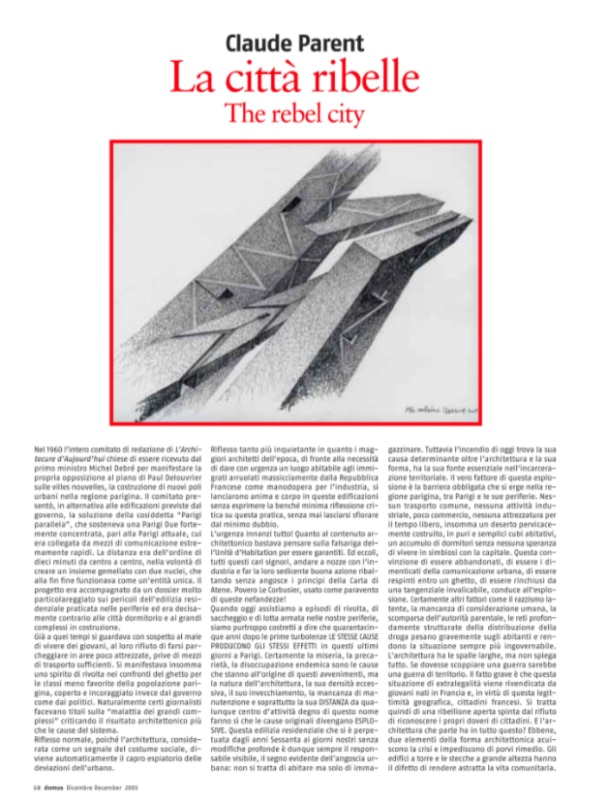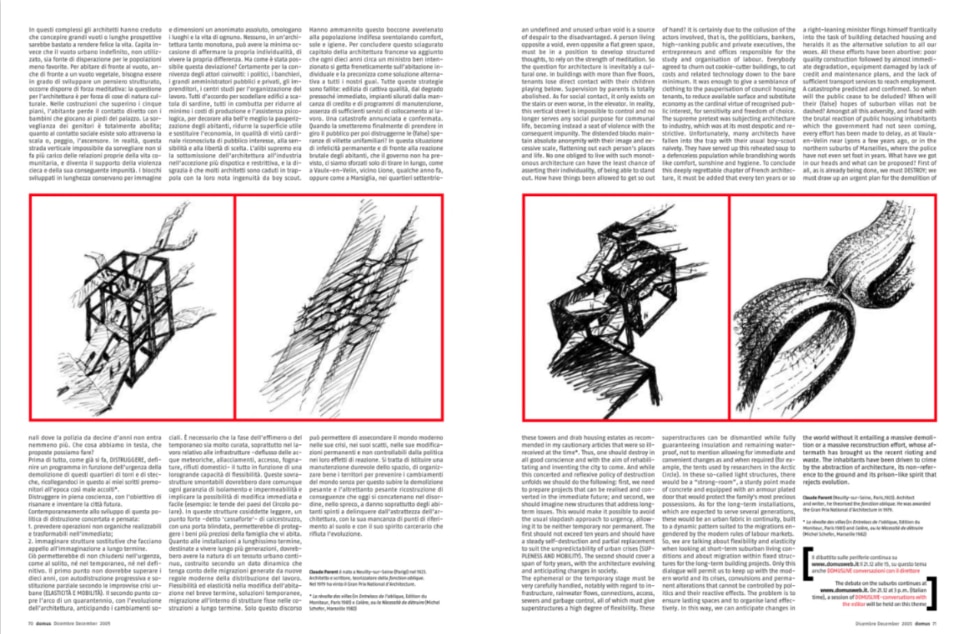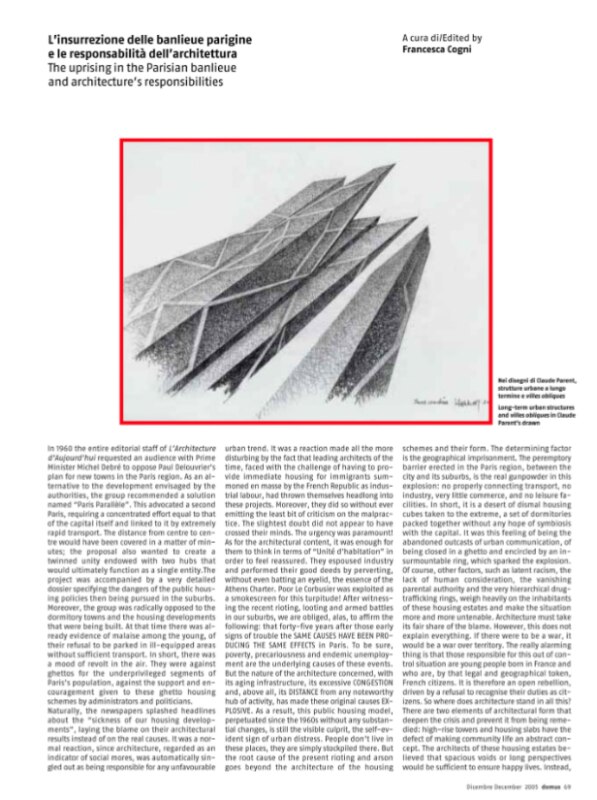The large residential settlements developed around French cities since the 1950s, with their lack of connections and services have given physical nature to segregation, to a perceivable regime of discrimination that was already clear within a few years from the first project completions.
Space is certainly not alone among the components sedimented in French cities since World War II, from which violent clashes have generated like in few other places. Still, it is the most visible: few components in fact have the power that space has, to sanction the success or failure of a social policy, to physically draw surfaces of cohesion or lines of segregation. Today, that same suburban landscape is the scene of the protests following the murder of Nahel Merzouk in Nanterre. As it had been for the 2005 riots that lasted for more than a month, which had started in Clichy-sous-Bois, in the eastern suburbs of Paris. The origin of a situation periodically showing as increasingly difficult to heal has a complex structure.
As early as 1960 the limitations and potentially harmful components of the expansion plans envisioned for the Parisian metropolis were visible, so much so that it had been Claude Parent, the radical architect of the function oblique and the Révolte des villes (revolt of the cities), to oppose this plan with a protest that was anything but simplistically anti-modern, proposing a seemingly utopian but as realistic an alternative, based on those components of a right to the city that later, as we have seen, would in fact punctually not have been provided. Domus devoted space and reflection to such questions in December 2005, on issue 887.

The rebel city
In 1960 the entire editorial staff of L’Architecture d’Aujourd’hui requested an audience with Prime Minister Michel Debré to oppose Paul Delouvrier’s plan for new towns in the Paris region. As an alternative to the development envisaged by the authorities, the group recommended a solution named “Paris Parallèle”. This advocated a second Paris, requiring a concentrated effort equal to that of the capital itself and linked to it by extremely rapid transport. The distance from centre to centre would have been covered in a matter of minutes; the proposal also wanted to create a twinned unity endowed with two hubs that would ultimately function as a single entity. The project was accompanied by a very detailed dossier specifying the dangers of the public housing policies then being pursued in the suburbs.
After witnessing the recent rioting, looting and armed battles in our suburbs, we are obliged, alas, to affirm the following: that forty-five years after those early signs of trouble the same causes have been producing the same effects in Paris.
Moreover, the group was radically opposed to the dormitory towns and the housing developments that were being built. At that time there was already evidence of malaise among the young, of their refusal to be parked in ill-equipped areas without sufficient transport. In short, there was a mood of revolt in the air. They were against ghettos for the underprivileged segments of Paris’s population, against the support and encouragement given to these ghetto housing schemes by administrators and politicians.
Naturally, the newspapers splashed headlines about the “sickness of our housing developments”, laying the blame on their architectural results instead of on the real causes. It was a normal reaction, since architecture, regarded as an indicator of social mores, was automatically singled out as being responsible for any unfavourable urban trend.
It was a reaction made all the more disturbing by the fact that leading architects of the time, faced with the challenge of having to provide immediate housing for immigrants summoned en masse by the French Republic as industrial labour, had thrown themselves headlong into these projects. Moreover, they did so without ever emitting the least bit of criticism on the malpractice. The slightest doubt did not appear to have crossed their minds.

The urgency was paramount! As for the architectural content, it was enough for them to think in terms of “Unité d’habitation” in order to feel reassured. They espoused industry and performed their good deeds by perverting, without even batting an eyelid, the essence of the Athens Charter. Poor Le Corbusier was exploited as a smokescreen for this turpitude!
After witnessing the recent rioting, looting and armed battles in our suburbs, we are obliged, alas, to affirm the following: that forty-five years after those early signs of trouble the same causes have been producing the same effects in Paris. To be sure, poverty, precariousness and endemic unemployment are the underlying causes of these events. But the nature of the architecture concerned, with its aging infrastructure, its excessive congestion and, above all, its distance from any noteworthy hub of activity, has made these original causes explosive.
As a result, this public housing model, perpetuated since the 1960s without any substantial changes, is still the visible culprit, the self-evident sign of urban distress. People don’t live in these places, they are simply stockpiled there. But the root cause of the present rioting and arson goes beyond the architecture of the housing schemes and their form. The determining factor is the geographical imprisonment. The peremptory barrier erected in the Paris region, between the city and its suburbs, is the real gunpowder in this explosion: no properly connecting transport, no industry, very little commerce, and no leisure facilities.
In short, it is a desert of dismal housing cubes taken to the extreme, a set of dormitories packed together without any hope of symbiosis with the capital. It was this feeling of being the abandoned outcasts of urban communication, of being closed in a ghetto and encircled by an insurmountable ring, which sparked the explosion. Of course, other factors, such as latent racism, the lack of human consideration, the vanishing parental authority and the very hierarchical drug-trafficking rings, weigh heavily on the inhabitants of these housing estates and make the situation more and more untenable. Architecture must take its fair share of the blame. However, this does not explain everything. If there were to be a war, it would be a war over territory. The really alarming thing is that those responsible for this out of control situation are young people born in France and who are, by that legal and geographical token, French citizens. It is therefore an open rebellion, driven by a refusal to recognise their duties as citizens. So where does architecture stand in all this? There are two elements of architectural form that deepen the crisis and prevent it from being remedied: high-rise towers and housing slabs have the defect of making community life an abstract concept.

The architects of these housing estates believed that spacious voids or long perspectives would be sufficient to ensure happy lives. Instead, an undefined and unused urban void is a source of despair to the disadvantaged. A person living opposite a void, even opposite a flat green space, must be in a position to develop structured thoughts, to rely on the strength of meditation. So the question for architecture is inevitably a cultural one. In buildings with more than five floors, tenants lose direct contact with their children playing below. Supervision by parents is totally abolished. As for social contact, it only exists on the stairs or even worse, in the elevator. In reality, this vertical street is impossible to control and no longer serves any social purpose for communal life, becoming instead a seat of violence with the consequent impunity. The distended blocks maintain absolute anonymity with their image and excessive scale, flattening out each person’s places and life.
No one obliged to live with such monotonous architecture can have the least chance of asserting their individuality, of being able to stand out. How have things been allowed to get so out these towers and drab housing estates as recommended in my cautionary articles that were so ill-received at the time*. Thus, one should destroy in all good conscience and with the aim of rehabilitating and inventing the city to come. And while this concerted and reflexive policy of destruction unfolds we should do the following: first, we need to prepare projects that can be realised and converted in the immediate future; and second, we should imagine new structures that address long-term issues. This would make it possible to avoid the usual slapdash approach to urgency, allowing it to be neither temporary nor permanent. The first should not exceed ten years and should have a steady self-destruction and partial replacement to suit the unpredictability of urban crises (suppleness and mobility). The second should cover a span of forty years, with the architecture evolving and anticipating changes in society.
The ephemeral or the temporary stage must be very carefully handled, notably with regard to infrastructure, rainwater flows, connections, access, sewers and garbage control, all of which must give superstructures a high degree of flexibility. These of hand? It is certainly due to the collusion of the actors involved, that is, the politicians, bankers, high-ranking public and private executives, the entrepreneurs and offices responsible for the study and organisation of labour. Everybody agreed to churn out cookie-cutter buildings, to cut costs and related technology down to the bare minimum. It was enough to give a semblance of clothing to the pauperisation of council housing tenants, to reduce available surface and substitute economy as the cardinal virtue of recognised public interest, for sensitivity and freedom of choice. The supreme pretext was subjecting architecture to industry, which was at its most despotic and restrictive.
Unfortunately, many architects have fallen into the trap with their usual boy-scout naivety. They have served up this reheated soup to a defenceless population while brandishing words like comfort, sunshine and hygiene. To conclude this deeply regrettable chapter of French architecture, it must be added that every ten years or so superstructures can be dismantled while fully guaranteeing insulation and remaining waterproof, not to mention allowing for immediate and convenient changes as and when required (for example, the tents used by researchers in the Arctic Circle). In these so-called light structures, there would be a “strong-room”, a sturdy point made of concrete and equipped with an armour plated door that would protect the family’s most precious possessions. As for the long-term installations, which are expected to serve several generations, these would be an urban fabric in continuity, built to a dynamic pattern suited to the migrations engendered by the modern rules of labour markets. So, we are talking about flexibility and elasticity when looking at short-term suburban living conditions and about migration within fixed structures for the long-term building projects. Only this dialogue will permit us to keep up with the modern world and its crises, convulsions and permanent alterations that cannot be controlled by politics and their reactive effects.
The problem is to ensure lasting spaces and to organise land effectively. In this way, we can anticipate changes in a right-leaning minister flings himself frantically into the task of building detached housing and heralds it as the alternative solution to all our woes. All these efforts have been abortive: poor quality construction followed by almost immediate degradation, equipment damaged by lack of credit and maintenance plans, and the lack of sufficient transport services to reach employment. A catastrophe predicted and confirmed. So when will the public cease to be deluded? When will their (false) hopes of suburban villas not be dashed? Amongst all this adversity, and faced with the brutal reaction of public housing inhabitants which the government had not seen coming, every effort has been made to delay, as at Vaulxen-Velin near Lyons a few years ago, or in the northern suburbs of Marseilles, where the police have not even set foot in years. What have we got in our heads and what can be proposed? First of all, as is already being done, we must destroy; we must draw up an urgent plan for the demolition of the world without it entailing a massive demolition or a massive reconstruction effort, whose aftermath has brought us the recent rioting and waste. The inhabitants have been driven to crime by the abstraction of architecture, its non-reference to the ground and its prison-like spirit that rejects evolution.
* La rèvolte des villes (in Entrelacs de l’oblique, Edition du Moniteur, Paris 1981) and Colère, ou la Nècessitè de dètruire (Michel Schefer, Marseille 1982)
Opening image: Fontenay-sous-Bois, photo by vmonet on AdobeStock


